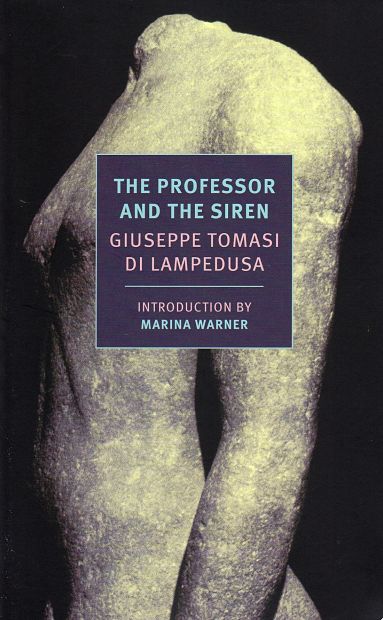The Professor and The Siren
Stephen Twilley’s new translation of Giuseppe Tomasi di Lampedusa’s last work The Professor and the Siren would appeal most to those who loved di Lampedusa’s masterpiece The Leopard, as both are beautifully written. Giuseppe Tomasi di Lampedusa witnessed the demise of his aristocratic family’s holdings in Sicily after the rise of Garibaldi and the subsequent unification of Italy. The Leopard’s story traces the aristocracy’s downfall in the person of Don Fabrizio Corbera, Prince of Salina, known as “the Leopard.” Stephen Twilley’s new translation of Giuseppe Tomasi di Lampedusa’s last work The Professor and the Siren would appeal most to those who loved di Lampedusa’s masterpiece The Leopard, as both are beautifully written. Giuseppe Tomasi di Lampedusa witnessed the demise of his aristocratic family’s holdings in Sicily after the rise of Garibaldi and the subsequent unification of Italy. The Leopard’s story traces the aristocracy’s downfall in the person of Don Fabrizio Corbera, Prince of Salina, known as “the Leopard.” The novel’s final unforgettable image is of the favorite dog Bendico’s decomposed body being thrown out a window and for a moment reconstructing itself in the air as a leopard.
That magical image is taken one step further in this short volume’s title story, the first of three separate stories in The Professor and the Siren. Here the great-grandson of Don Fabrizio, the journalist Paolo Corbera, meets an elderly professor Rosario La Ciura whose superior attitude and general displeasure are explained by his story. When La Ciura was a beautiful young man, his boat was disturbed by the appearance of a sixteen-year-old with the top of a human and, below the waist, the body of a fish—a siren or mermaid:
Not for nothing was she the daughter of Calliope: Oblivious to all cultures, ignorant of all wisdom, disdainful of any moral constraints whatsoever, she was nevertheless part of the source of all culture, of all knowledge, of all ethics, and she knew how to express this primitive superiority of hers in terms of rugged beauty. ‘I am everything because I am only the stream of life, free of accident. I am immortal . . . You are young and handsome. You should follow me into the sea now and escape sorrows and old age.’
[. . .]
That lascivious girl, that cruel little beast, had also been the wisest of Mothers; with her mere presence she’d uprooted faiths, dispelled metaphysics; with her fragile, often bloodstained fingers she’d shown me the path toward true eternal peace, and also toward an asceticism based not on sacrifice but on the impossibility of accepting other, inferior pleasures.
The other two stories are not mythical but realistic. “Joy and the Law” is a story of buona figura, the Italian version of saving face. A poor accountant is given a large panettone (a sweet bread available around Christmastime) by his fellow workers, which he considers a gift, but which his wife rightly assesses is an act of charity. However, because a wealthy friend has done a favor for the family, she insists he give the panettone to him and buy a smaller one for the family. In addition, he has to buy a second cake and drinks for his fellow workers to thank them. The poor accountant is burdened from beginning to end of this story, as his obligations snowball, and we sense di Lampedusa’s ironic sense of humor.
The final story “The Blind Kittens” carries on with the author’s wry humor. The title is unclear, only because it is the first chapter of an unfinished novel (di Lampedusa died of cancer in 1957 before finding a publisher). However, again in this final work, first translated in 1960, we sense the influence of the 1958 work, The Leopard. An upstart in the novel Don Calogero Sedara exemplifies the opportunistic, self-made man who is displacing the old aristocratic order. His type of character becomes “The Blind Kittens” main character, Don Batassano Ibba, the child of illiterates, who amasses great treks of land over the years. His advance has “been as fast as a headlong fall, like a knife in lard.” What amuses in this opening to the unfinished novel is the scene of the nobility sitting around their clubs, dreaming up more and more outrageous stories of Ibba’s numerous crimes:
This time Santa Giulia had truly made an impression; to a man his listeners sat stunned. Not that they believed him, but they found the fantasy highly poetic; each of them wished for Ibba’s millions so that others would invent similarly sumptuous lies about him.
[. . .]
The castle of lies was clearly extremely fragile, but so beautiful—made up of women’s thighs, obscene acts without names, great painters, and one 1000,000 lire bills—that no one wanted to blow on it and make it fall.
For fans of Giuseppe di Lampedusa’s The Leopard, his final work will be a delight. The Professor and the Siren’s title story gives the nostalgia of a golden age gone—the connection of Sicily with ancient Greek myths. The other two stories will satisfy for the wry ironic sense of humor.





